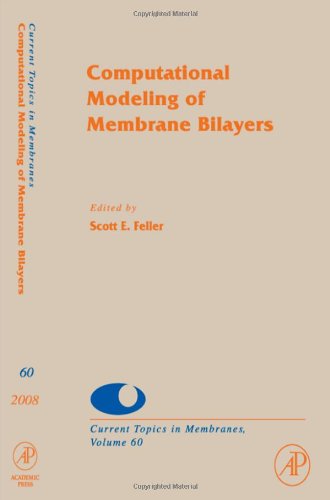

Most ebook files are in PDF format, so you can easily read them using various software such as Foxit Reader or directly on the Google Chrome browser.
Some ebook files are released by publishers in other formats such as .awz, .mobi, .epub, .fb2, etc. You may need to install specific software to read these formats on mobile/PC, such as Calibre.
Please read the tutorial at this link: https://ebookbell.com/faq
We offer FREE conversion to the popular formats you request; however, this may take some time. Therefore, right after payment, please email us, and we will try to provide the service as quickly as possible.
For some exceptional file formats or broken links (if any), please refrain from opening any disputes. Instead, email us first, and we will try to assist within a maximum of 6 hours.
EbookBell Team

5.0
68 reviews
ISBN 10: 0080879703
ISBN 13: 9780080879703
Author: Sidney Simon, Scott Feller, Dale Benos
Current Topics in Membranes provides a systematic, comprehensive, and rigorous approach to specific topics relevant to the study of cellular membranes. Each volume is a guest edited compendium of membrane biology.
Chapter 1. Considerations for Lipid Force Field Development
I. Introduction
II. Quantum Mechanics and Molecular Dynamics Based Parameter Optimization
III. Membrane Targets and Related Issues
IV. Summary and Perspectives
References
Chapter 2. Electrostatics in Biomolecular Simulations: Where Are We Now and Where Are We Heading?
I. Introduction
II. Importance of Long-Range Interactions in Simulations of Biological Systems
III. Overview of Methods and Their Applicability
IV. Non-Periodic Systems and Different Boundary Conditions
V. Applications and Latest Methodological Developments
VI. Final Notes on Software, Accuracy, and Speed
References
Chapter 3. Time and Length Scales in Lipid Bilayer Simulations
I. Introduction
II. Area per Lipid and Finite Size Effects
III. Undulations
IV. Peristaltic Fluctuations
V. Hydrocarbon Chain Dynamics
VI. Lateral Diffusion of Lipids
References
Chapter 4. Molecular Dynamics Simulation of Lipid-Protein Interactions
I. Introduction
II. Force Fields
III. Combining Force Fields
IV. Sampling Concerns
V. Validation of Lipid-Protein Simulations
VI. Conclusion and Perspective
References
Chapter 5. Implicit Modeling of Membranes
I. Introduction
II. Classes of Models
III. Interesting Problems in Implicit Membrane Modeling
IV. Conclusion
References
Chapter 6. Blue Matter: Scaling of N-Body Simulations to One Atom per Node
I. Introduction
II. Background on Massively Parallel Biomolecular Simulation
III. Inherent Concurrency of Molecular Dynamics
IV. Parallel Decompositions
V. Results
VI. Summary and Conclusions
References
Chapter 7. Multiscale Simulation of Membranes and Membrane Proteins: Connecting Molecular Interactio
I. Multiscale Aspects of Membrane Simulation: A Brief Review
II. New Multiscale Methods for Membrane Simulations
III. Selected Applications
IV. Summary
References
Chapter 8. Interactions between Small Molecules and Lipid Bilayers
Abbreviations
I. Introduction
II. Partitioning of Small Molecules in Lipid Bilayers
III. Conclusions
References
Chapter 9. On the Nature of Lipid Rafts: Insights from Molecularly Detailed Simulations of Model Bio
I. Introduction
II. Simulations
III. Concluding Remarks
References
Chapter 10. Atomistic and Mean Field Simulations of Lateral Organization in Membranes
I. Introduction
II. Molecular Dynamics Simulation of Hydrated Lipid Bilayers
III. General Issues in Force Feld Development for Biomolecular Simulations
IV. Simulation of Heterogeneous Lipid membranes
V. Application: A Mean Field Based Lipid Bilayer Model Based on MDSimulations
VI. Summary
References
Chapter 11. Molecular Modeling of the Structural Properties and Formation of High-Density Lipoprotei
I. Introduction
II. Methods
III. Structure of Discoidal HDL
IV. Formation of Discoidal HDL
V. Conclusions
References
Chapter 12. Gas Conduction of Lipid Bilayers and Membrane Channels
I. Introduction
II. Computational Methodology
III. Lipid-Mediated Gas Conduction
IV. Protein-Mediated Gas Conduction
V. Concluding Remarks
References
Chapter 13. A Brief Introduction to Voltage-Gated K+ Channels
I. Introduction
II. Structure of Kv Channels and Gating Mechanisms
III. Free Energy and Membrane Voltage
IV. Conclusion
References
Chapter 14. Computational Models for Electrified Interfaces
I. Introduction
II. General Concepts of Surface Charge and Co/Counter Ions
III. Continuum Models
IV. Bridging from the Continuum to Molecular Calculations
V. All-Atom Models
VI. Long-Term Trends
VII. Summary
References
Chapter 15. Charged Protein Side Chain Movement in Lipid Bilayers Explored with Free Energy Simulati
I. Introduction
II. Theoretical Perspectives
III. Experimental Hydrophobicity and Membrane Partitioning Models
IV. Fully Atomistic Computer Simulations
V. Reconciling Simulation and Experiment
VI. Conclusion and Implications
References
Index
computational modeling biology
computational modeling of biological systems
computational modeling of realistic cell membranes
a computational model of neurodegeneration in alzheimer’s disease
biomembrane simulations computational studies of biological membranes
Tags: Sidney Simon, Scott Feller, Dale Benos, Computational Modeling, Membrane Bilayers